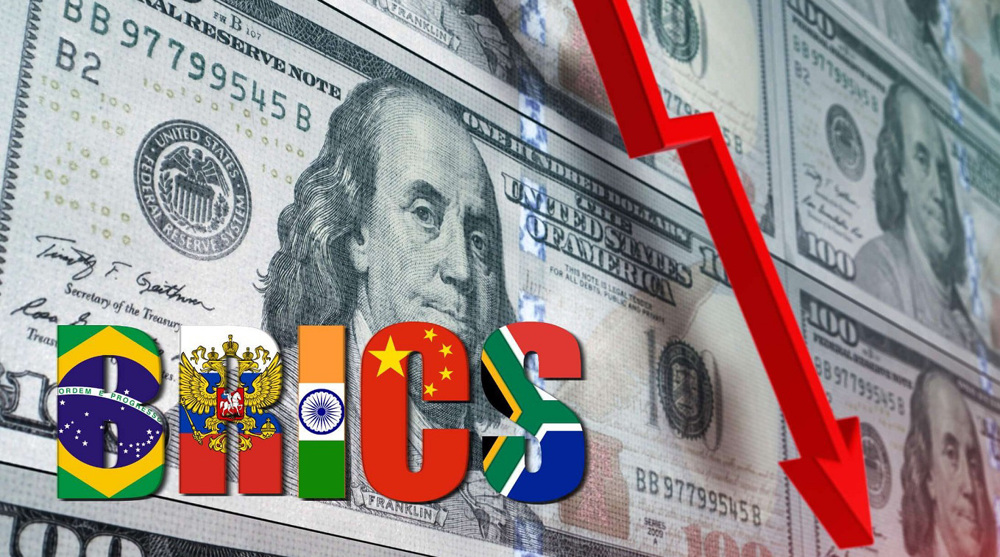
As the 17th BRICS Summit wrapped up in Rio de Janeiro last week, global attention was drawn not only to the bloc’s growing influence but also to the increasingly confrontational tone from Washington.
President Donald Trump’s threat to impose a 10 percent tariff on any country aligning with what he described as “anti-American” BRICS policies highlights the deep anxiety within the US establishment over the declining role of the dollar in global trade.
Rather than projecting strength, this reaction reveals mounting concern that the United States is losing its firm hold on the financial tools that have sustained its global dominance for decades.
Central to this unease is the ongoing process of “de-dollarization,” which is largely driven by the expanding BRICS coalition.
BRICS, originally formed in 2009 by Brazil, Russia, India, and China—with South Africa joining in 2010—has transformed from a symbolic acronym into a significant geopolitical and economic bloc.
The group’s recent expansion in January 2024, welcoming Iran, Egypt, Ethiopia, and the United Arab Emirates, with Indonesia expected to join in 2025, signals its broadening clout to reshape global power structures.
Together, its member states represent more than half of the world’s population and command substantial shares of global natural resources, industrial production, and trade potential.
BRICS has been described as more than a simple economic coalition. It is seen as a platform to rethink and reshape global governance, with the aim of moving away from an outdated 20th-century economic order dominated by the US dollar and establishing a more inclusive and multipolar global system.
The dollar’s role as the world’s primary reserve currency and the default medium of international trade remains one of the US’s most powerful instruments of influence.
This dominance enables the US to impose sanctions beyond its borders, manage global liquidity, and attract foreign capital on advantageous terms.
However, this position has come under growing pressure, especially from countries like Iran and Russia that have endured harsh sanctions enforced through the dollar system.
In response, BRICS members have been actively developing alternative financial systems, payment networks, and potentially new currencies to reduce their reliance on the dollar.
This includes bilateral trade agreements settled in local currencies, the issuance of bonds in member currencies by the BRICS New Development Bank, and the creation of new payment mechanisms designed to bypass the traditional dollar-based channels.
Already, China and Russia conduct a significant share of their bilateral trade using their own currencies, while India and Iran are exploring similar arrangements.
Should these initiatives be expanded and coordinated across the bloc, they could significantly undermine the dollar’s dominant role in the global economy over time.
Trump’s tariff threat reflects a broader “America First” economic strategy characterized by protectionism, bilateral leverage, and the maintenance of a strong dollar as both an economic and political weapon.
However, experts view tariffs as a temporary tactic that will not halt the structural transformation reshaping the global financial system.
The fact that Washington feels compelled to threaten trading partners simply for engaging with a multilateral group like BRICS exposes the vulnerability of the dollar-based system amid a waning global confidence in US financial leadership.
Historical patterns show that hegemonic powers tend to champion free trade primarily when they hold technological and economic superiority.
As those advantages fade, protectionist measures such as tariffs and sanctions often increase—a dynamic evident in the decline of the British Empire during the mid-20th century.
For Iran, the BRICS alliance offers far more than geopolitical symbolism; it represents a crucial economic lifeline.
Subjected to years of Western sanctions and financial isolation, Iran views membership as an opportunity to connect with dynamic economies outside the US sphere of influence.
This integration opens access to alternative banking systems, new trade routes, infrastructure funding, and currency mechanisms that could alleviate Tehran’s economic challenges.
Iran’s industrial and technological capacities, especially in energy, mining, petrochemicals, and transportation, align well with BRICS’ objectives for coordinated growth.
Improved collaboration in logistics, innovation, and supply chain resilience among member states can open up new pathways for economic growth.
Despite these developments, the dollar still accounts for roughly 88% of all international currency transactions, illustrating the depth of its entrenchment.
However, the readiness of major economies to invest in long-term alternatives presents a significant challenge to the current post-Cold War economic order, which has been dominated for decades by the dollar and Western-led institutions.
For emerging markets and countries like Iran, this transitional phase presents both opportunity and risk.
While aligning with BRICS can bring economic benefits and greater political influence, it also carries risks including potential US retaliation, internal divisions within the bloc, and the daunting technical challenges of building reliable financial infrastructure outside the existing system.
Looking ahead, the future global economic landscape will depend heavily on how BRICS evolves and how the United States responds to this multipolar challenge to its financial supremacy.
Having said that, the post-Cold War order, maintained for more than three decades by dollar dominance and Western institutions, faces its most serious test in decades.
The BRICS summit in Rio last week underscored a growing momentum toward a multipolar global economy. The threat of tariffs by Washington highlights the perceived threat this shift poses to the US dollar’s central role.
While the greenback remains dominant, the economic strategies pursued by BRICS members reveal a long-term effort to build an alternative global economic architecture—one less dependent on the dollar and more reflective of today’s diverse world order.